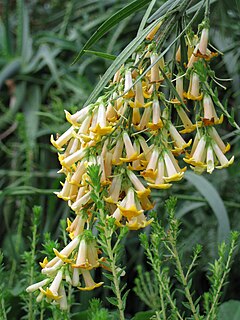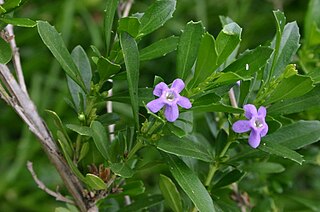
Elephantiasis is the enlargement and hardening of limbs or body parts due to tissue swelling. It is characterised by edema, hypertrophy, and fibrosis of skin and subcutaneous tissues, due to obstruction of lymphatic vessels. It may affect the genitalia. The term elephantiasis is often used in reference to parasitic worm infections, but may refer to a variety of diseases where parts of a person's body swell to massive proportions.

The ring-necked dove, also known as the Cape turtle dove or half-collared dove, is a widespread and often abundant dove species in East and southern Africa. It is a mostly sedentary bird, found in a variety of open habitats. Within range, its penetrating and rhythmic, three-syllabled crooning is a familiar sound at any time of the year. Its name is derived from the semi-collar of black feathers on the lower nape, a feature shared with a number of Streptopelia species. Like all doves, they depend on surface water. They congregate in large flocks at waterholes in dry regions to drink and bathe.

The northern bettong is a small potoroid marsupial which is restricted to some areas of mixed open Eucalyptus woodlands and Allocasuarina forests bordering rainforests in far northeastern Queensland, Australia. They are known as "rat kangaroos" and move about in a slow hopping manner. There are five different species in Australia of this particular animal. It is about the size of a rabbit with a large tail dragging behind.

Bettongs, species of the genus Bettongia, are potoroine marsupials once common in Australia. They are important ecological engineers displaced during the colonisation of the continent, and are vulnerable to threatening factors such as altered fire regimes, land clearing, pastoralism and introduced predatory species such as the fox and cat.

Kenkey is a staple dish similar to sourdough dumpling from the Ga and Fante-inhabited regions of West Africa, usually served with pepper sauce and fried fish or soup, stew.

Freylinia lanceolata is a South African shrub belonging to the family Scrophulariaceae.

The black-bellied storm petrel is a species of seabird in the family Oceanitidae.

Bolbitis heudelotii, also known as the African water fern, creeping fern, and Congo fern, is native to subtropical and tropical Africa, from Ethiopia west to Senegal; and down to northern South Africa.

Malolo is an inhabited volcanic island in the Pacific Ocean, near Fiji. Malolo was used as a tribe name in Survivor: Ghost Island. Malolo Island is the largest of the Mamanuca Islands and is home to two villages.

Vespa tropica, the greater banded hornet, is a tropical species of hornet found in Southern Asia, New Guinea and west Africa, and which has recently been discovered to be an invasive species on the Pacific island of Guam. It is a predator of paper wasps and possesses a potent sting, which can cause extreme pain and swelling.

Leishmania tropica is a species of flagellate parasites that infects humans and hyraxes, and the cause of the disease Leishmaniasis RecidivansOr bugdadsore, a form of cutaneous leishmaniasis. L. tropica infection results in non-ulcerating disease. Cause Oriental sores<Korean J. Parasitol. 2007 Jun;45(2):103-9.> <Mahmoudzadeh-Niknam H1, Kiaei SS, Iravani D.>
A trypanocidal agent is an antiprotozoal agent that acts upon trypanosome parasites.

Bowiea is a bulbous genus of perennial, succulent plants which thrive in dry and desert regions of eastern and southern Africa. It is native to a region stretching from Kenya to Cape Province.
Freylinia crispa is a flowering plant in the figwort family.
Persoonia tropica is a plant in the family Proteaceae and is endemic to north Queensland. It is an erect shrub to small tree shrub with branchlets that are hairy when young, narrow elliptic to lance-shaped leaves and yellow flowers in groups of three to ten on a rachis 3–10 mm (0.12–0.39 in) long that continues to grow after flowering.

Desmarestia tropica, sometimes called tropical acidweed, is a species of seaweed in the family Desmarestiaceae. It is critically endangered, possibly extinct, and one of only fifteen protists evaluated by IUCN. Endemic to the Galápagos Islands, the specific epithet tropica alludes to its tropical habitat, rare for members of Desmarestiales. The common name acidweed applies to members of the genus Desmarestia, generally characterized by fronds containing vacuoles of concentrated sulfuric acid, but it is unclear if this species also produces acid.
Pseudorhaphitoma tropica is a small sea snail, a marine gastropod mollusk in the family Mangeliidae.

Freylinia is a genus of flowering plants in the figwort family Scrophulariaceae. They are native to Africa.

The Tropica or Tropica Roadster is an all-electric car made by Renaissance Cars in the 1990s. It was introduced for the model year 1995 and built in a limited number of units, but never entered series production due to financial issues.















